Low Carbon Design Project - First Consultation 091118a
双碳实验室建筑标准
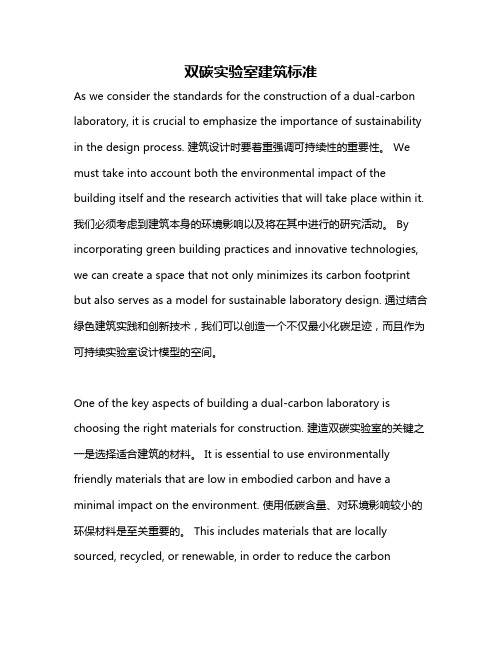
双碳实验室建筑标准As we consider the standards for the construction of a dual-carbon laboratory, it is crucial to emphasize the importance of sustainability in the design process. 建筑设计时要着重强调可持续性的重要性。
We must take into account both the environmental impact of the building itself and the research activities that will take place within it. 我们必须考虑到建筑本身的环境影响以及将在其中进行的研究活动。
By incorporating green building practices and innovative technologies, we can create a space that not only minimizes its carbon footprint but also serves as a model for sustainable laboratory design. 通过结合绿色建筑实践和创新技术,我们可以创造一个不仅最小化碳足迹,而且作为可持续实验室设计模型的空间。
One of the key aspects of building a dual-carbon laboratory is choosing the right materials for construction. 建造双碳实验室的关键之一是选择适合建筑的材料。
It is essential to use environmentally friendly materials that are low in embodied carbon and have a minimal impact on the environment. 使用低碳含量、对环境影响较小的环保材料是至关重要的。
绿色低碳建筑设计实例分析——宜昌规划展览馆

0 引言
建筑节能减排对减少气候变化ꎬ实现可持续发展 意义重大ꎮ 随着绿色低碳概念的推广、应用ꎬ需要更 多地从建筑全生命周期考量节能减排ꎮ 作为对城市 发展进行集中展示的规划展览馆ꎬ其高星级的绿色低 碳建筑设计实践ꎬ将对一个城市乃至一个区域绿色低 碳建筑的发展都将起到重要的促进作用ꎮ 本文将以 宜昌规划展览馆项目的绿色低碳设计理念为基础ꎬ对 该项目全寿命周期的二氧化碳排放情况进行分析ꎬ旨 在初步掌握绿色建筑的碳排放情况ꎮ
DING Yun1 ꎬ CHEN Rong2 ꎬ HUANG Liang1 (1������ Hubei Provincial Academy of Building Research and Designꎬ Wuhan 430071ꎬ Chinaꎻ 2������ Yichang City Construction Investment Development Co������ LTDꎬ Yichang 443000ꎬ Hubeiꎬ China) Abstract:Following the trend of the global energy conservation and emission reductionꎬ green and low carbon building will gradually require higher demands for architecture design. As the first Three - star Green Building project - Planning Exhibition Hall of Yichangꎬ which employs 24 green technology systems in the design phaseꎬ and uses green concept among the building materialsꎬ constructionꎬ useꎬ maintenance and so on. The green and low carbon design techniques of the project - Planning Exhibition Hall of Yichang are analyzedꎬ expounding the green and low carbon building techniques which are suitable for Yichangꎬ and Hubei Province. Keywords:Three - star Green Buildingꎻ energy savingꎬ land savingꎬ water savingꎬ material saving and environmental protectionꎻ carbon emissionꎻ design practice
设计碳中和路径的英文

设计碳中和路径的英文To achieve carbon neutrality, we must first focus on reducing greenhouse gas emissions across all sectors of society. This involves transitioning to renewable energy sources, improving energy efficiency, and implementing carbon capture technologies.In the energy sector, transitioning from fossil fuels to renewable sources such as solar, wind, and hydro power is crucial in reducing carbon emissions. This shift not only reduces greenhouse gas emissions, but also promotes energy security and creates new job opportunities in the renewable energy industry.Improving energy efficiency in buildings, transportation, and manufacturing processes is another key component of achieving carbon neutrality. This involves using energy-efficient technologies, reducing waste, and implementingsustainable practices to minimize energy consumption and carbon emissions.Carbon capture and storage technologies play a crucial role in capturing carbon dioxide emissions from industrial processes and power plants before they are released into the atmosphere. This involves capturing carbon dioxide andstoring it underground or utilizing it for enhanced oil recovery or other industrial processes.Furthermore, reforestation and afforestation efforts can help offset carbon emissions by sequestering carbon dioxide through the growth of trees and other vegetation. Forest conservation and sustainable land management practices are essential for maintaining healthy ecosystems and mitigating the effects of climate change.In addition to these mitigation measures, it is also important to actively remove carbon dioxide from the atmosphere through carbon removal technologies such as directair capture and enhanced weathering. These technologies have the potential to play a significant role in achieving carbon neutrality by removing excess carbon dioxide from the atmosphere and storing it in a safe and permanent manner.Transitioning to a circular economy that minimizes waste and promotes recycling and reuse of materials can also help reduce carbon emissions by reducing the need for new production and minimizing the use of finite resources.Public awareness and education are key factors in driving the transition to a carbon-neutral society. By raising awareness about the importance of reducing carbon emissions and promoting sustainable practices, individuals and communities can take action to reduce their carbon footprint and support the transition to a low-carbon economy.In conclusion, achieving carbon neutrality requires a concerted effort from governments, businesses, andindividuals to reduce carbon emissions, transition torenewable energy sources, improve energy efficiency, and implement carbon capture and removal technologies. By working together towards a common goal of carbon neutrality, we can create a sustainable future for generations to come.。
重庆市2024届普通高等学校招生全国统一考试高考模拟调研(二)英语试卷(含答案)

重庆市2024届普通高等学校招生全国统一考试高考模拟调研(二)英语试卷学校:___________姓名:___________班级:___________考号:___________ 一、阅读理解Belt and RoadDozens of oil paintings, prints, sculptures and other works of fine arts are on show at the National Art Museum of China until Sept 26 to mark the 10th anniversary of the Belt and Road Initiative. Pieces on show come from the countries and regions involved in the BRI to convey the spiritual state and vision of Chinese civilization in a dialogue of openness with world art.10 am-5 pm, daily. Building 27, 266 Tinglan Street, Linping district, Hangzhou, Zhejiang province.Figures in inklnk artist Lu Zhiqiang says that as he gets older, he feels more of the difficulties of painting. He has been exploring ways to capture the spirituality of his s ubjects. Lu’s ongoing solo exhibition at the China National Academy of Painting, through to Friday, explorers the artist’s long-term experimentation with figure painting.9 am-11:30 am, 1:30-4:30 pm, daily. 54 Xisanhuan Beilu, Haidian district. 010-6841-2606.Vibrant Han artThe brick and stone from the Han Dynasty (206 BC-AD 220) are known for their highly illustrative style, and provide an overview of history, geography, astronomy and other aspects of life that reveals the extent of the knowledge people at the time had about themselves and the world. The wealth of information the images contain still inspires artists today. The show marks the inauguration (落成典礼) of Inxx Gallery, and runs until Sept 26.9 am-5 pm, closed on Mondays. 1 Wusi Dajie, Dongcheng district, Beijing.010-6400-1476.Underneath surfaceWu Wei’s current exhibition, titled Fur and Golden, reminds people in a clever way that their eyes can betray them. A first look at his color pieces leads viewers to believe that the artist is working with fur. In fact, the pieces are actually made of paper, intricately (复杂地) cut to copy the look and texture of fur. The exhibition is running at Tang Contemporary Art until Saturday.11 am-6:30 pm, closed on Mondays. D06, 798 art zone, Chaoyang district, Beijing.010-5978-9610.1.At the China National Academy of Painting, people can enjoy________ .A. paintings centered on the Belt and RoadB. figure paintings by Lu ZhiqiangC. prints and sculptures by Wu WeiD. various works from many artists2.What do Inxx Gallery and Tang Contemporary Art have in common?A. They are in the same district.B. They contain exhibits from the Han Dynasty.C. They invite artists from abroad.D. They are closed once a week.3.In which section of a website can you find the text?A. On Sales.B. Contemporary Art.C. What’s on.D. Lifestyle.It was the middle of third grade and I am not sure what had gotten into me. I lied for no reason at all and about the daffiest things. I lied that I had eaten all my dinner. I lied that I had brushed my teeth. My lies were not hurting anyone, but I felt the need to say things that were not so.My parents tried everything to understand why I made up stuff. Was I looking for attention? Maybe. I soon realized the new attention I was getting was horrible. I was labeled a liar and my parents did not trust me.My sisters and I were invited to spend the weekend with my aunt. We all loved the times at Aunt Kim’s house because she spoiled us. She gave us the perfect food—hot dogs and cheese. She had cool pencils, erasers and other supplies that any young girl would love to have.Then it happened... someone took one of Aunt Kim’s art pencils and drew across the entire top of the wall.When Aunt Kim discovered the destruction, all three of us were asked to confess(承认). Nobody did! She told us how disappointed she was and was on the phone with my parents. They were on their way to pick me up!It had to be me! I was the liar. No amount of protesting could convince any of them that I had not committed the crime. I was taken home and sent to my room for the test of the day.And then there was a knock at the front door! Aunt Kim was standing there. It turns outmy younger sister finally felt guilty! She confessed that she was the oneFunny, I don’t even remember being m ad at my sister. I learned a valuable lesson. No matter how big or small your lies, once you are labeled a liar, earning trust takes a lot of work and time. I promised myself right then I would be an honest person.4.What does the underlined word “daffiest” mean in Paragraph 1?A. CleverestB. SilliestC. Funniest.D. Ughest5.What was my parents’ reaction to my lying?A. They didn’t put their trust in me.B. They were willing to believe me.C. They didn’t love me anymore.D. They regretted to trust me.6.What might happen to the author in the near future?A. She might hate her aunt.B. She would blame her sister.C. She might leave her family.D. She would never lie again.7.What did the author intend to express?A. A lie may take care of the present and future.B. We never know the love of the parentsC. To have a bad reputation is to be half hanged.D. Every family has its own source of shame.Most of us know what it’s like to get presents from friends. Whether it’s for a birthday or other celebration, it’s hard to beat the excitement of opening a carefully wrapped box to find something that’s both unexpected and suits you perfectly. Now, imagine if you could get the same feeling when you go shopping for yourself. That’s the feeling that mystery boxes ho pe to create.Mystery boxes are not a new idea — they were a feature of department stores in Japan in the early 20th Century. They contain a range of different products, which are sold at a lower price than their combined value. The key thing is that custo mers don’t know what’s in the box before they buy. All kinds of mystery boxes are available: fashion boxes, food boxes, beauty boxes, even loot boxes, which are virtual items for video games.The pleasant surprise is not the only attraction of mystery boxes. They also allow people to try things that they otherwise wouldn’t. Seasonal vegetable subscription boxes might lead people to learn to cook new meals. They can also potentially offer great savings — as the recommended retail (零售) price of the contents is often far higher than the purchase price. For retailers and suppliers the benefits are clear —it allows them to sell unwanted stock. British fashion mystery box entrepreneur Mario Maher highlight s how mystery boxes canhelp reduce the amount of waste in the fashion industry. People might discover product ranges that would otherwise be thrown away.There is an obvious downside to mystery boxes —when you buy them, you don’t know what you’ll get! It may be that the goods inside are not to your taste, but there is also the potential for criminals to make use of the unpredictability of mystery boxes to send items that have a much lower value than the price of the box.So, are mystery boxes a fun way of reducing waste and making shopping more exciting, or more an opportunity for disappointment, or worse — deception (欺骗)?8.What is Paragraph 2 mainly about?A. The price of mystery boxes.B. The definition of mystery boxes.C. The function of mystery boxes.D. The popularity of mystery boxes.9.What can be inferred from Paragraph 3?A. Mystery boxes contribute to producing waste.B. Buying mystery boxes is definitely a waste of money.C. The goods inside mystery boxes are not worth the price.D. Mystery boxes are welcome among customers and fashion industry.10.W hat is the author’s attitude towards mystery boxes?A. FavorableB. Indifferent.C. Pessimistic.D. Objective.11.How is the passage developed?A. By making analysis.B. By describing process.C. By presenting research results.D. By explaining cause and effect.We’re all familiar with the idea of climate change and how our planet is warming. Extremes in temperature have become more commonplace, making parts of the world difficult to live in. But one place where extreme heat is making life very uncomfortable is our cities. Luckily, innovation might be keeping it under control.As thermometers(温度计) record temperatures, sometimes above 50 degrees Celsius, solutions are being sought to cool the air in our cities. In India, for example, heatwaves and rapid urbanization have led to a big rise in the use of air-conditioning units, adding to CO2 emissions. So, architects, looking for a sustainable cooling solution, are copying an ancient lattice (框架) design, used in old buildings like the Taj Mahal, to construct comfortable,low-carbon buildings. Yatin Pandya told the BBC: “Traditional architectural forms have proven their performance in combating environmental conditions.”In America, about 80% of the population lives in cities, and it’s these cities that sufferfrom an urban heat island effect, caused by factors such as trapped waste heat, concrete structures and pavements absorbing the sun and tall buildings blocking the wind. Residents and developers have tried to cool these places by planting large trees that offer shade and putting plants and gardens on top of roofs to help trap heat. And in Los Angeles, there’s a experiment to cover street s with light-coloured material that reflects rather than absorbs the sun and so they remain cooler than typical black roads.But it’s satellites in space that are really giving us the best picture of our over-heated cities. Glynn Hulley, who is leading an image-capturing project, called the Land Surface Temperature Monitoring mission, told the BBC: “The data can be used to identify hot spots, weak regions, and assess the cooling impacts of heat mitigation (缓解) approaches.” It’s already found how green spaces, white roads and water features, have helped prevent our cities from boiling over. But with extreme heat still posing a threat to our lives, more solutions are still needed.12.What leads to the increase of CO₂ emissions?A. Invention of thermometers.B. Imitation of traditional architecture.C. Building of concrete structures.D. Application of air-conditioning units. 13.Why is Los Angeles mentioned?A. To prove it is miserable to suffer from heat.B. To show people are trying to solve problem.C. To demonstrate the benefit of modern buildings.D. To support the idea of low-carbon construction.14.What is the Land Surface Temperature Monitoring aimed at?A. Evaluating the cooling effect.B. Identifying city featuresC. Emphasizing threats to livesD. Testing image capturing technology.15.Which of the following can be the best title for the passage?A. Cities in DangerB. Dramatic Climate ChangeC. Temperature Monitoring MissionD. Cooling Hot Cities二、七选五16.Productivity can be a struggle for many of us. Overflowing (堆积的) email inboxes, housework, social obligations — it can be easy to feel overwhelmed. However, one simple tool that can help us stay updated is the to do list. ① _________There are three key reasons why lists are beneficial. Firstly, they help to reduce anxiety that comes with having never ending tasks. By writing everything down, we don’t have to rely on our memory and can instead focus on the task at hand. ② _________ As well as this, our brains are more likely to remember information that is presented in a structured and organized manner. And finally, lists serve as proof of what we have achieved. ③ _________④ _________ This is the name psychologists use for when we remember things we needto do our unfinished tasks, better than things we have already completed. Researchers from Wake Forest University tested the interference of the Zeigarnik effect on a group of people.⑤ _________ It was stopped half way through and only some people were allowed to make plans. The researchers found that the group permitted to plan bad reduced anxiety and performed better in the second task. The problem was, the others still had the warm up talk stuck in their active memory. So, once we tick something off our list, our brain forgets aboutit and we can relax.All in all, it seems lists are a valuable tool for staying updated!A. The experiment began with a warm up task.B. Write it down, do the tasks and cross them off — simple!C. They can help boost our sense of accomplishment and motivation.D. A to do list item is the kind of thing that will take long hours of work.E. Secondly, lists provide structure and guidance, giving us a plan to follow.F. However, in the never-ending sea of tasks, you feel like you aren’t keeping up.G. Another possible reason our brains love lists is because of something called the “Zeigarnik Effect”.三、完形填空(15空)I had a lovely beautiful strange aunt named Margita. She always wore colorful clothing and had a colorful 1 to match. She graduated from The Juilliard School of Music in Manhattan, having studied 2 opera singing. She went on to teach voice at Juilliard and later 3 the world as a member of the Manhattan Opera company.When I was young, she surprised me with an outing to see the 4 Mary Poppins. We were seated in the front row. Toward the end of the movie, the lead actor sang a cheerful song with 5 , “Let’s go fly a kite, up where the air is light...”After the first refrain(副歌), a background chorus in the movie joined in singing. 6 at this moment, my aunt popped out of her seat, turned and 7 the audience. I instantly slipped down in my seat, unsure of what was happening. Then in perfect 8 , she sangalong with the chorus loudly in her Julliard trained operatic voice. As she 9 her arms wide open, she graciously shared her gift with all the moviegoers. She 10 and powerfully sang the entire song with the chorus, as though she had been personally 11 to do so.When the song was finished, the entire audience stood up and gave her a thunderous 12 ! I slowly slid back up in my seat and cautiously looked around me. My little self was absolutely 13 by her magnificent voice and the crowd’s cheerful response. I instantly14 from being slightly 15 to feeling immensely proud of her. It was a wonderful surprise, a gift that life sometimes hands us.17.A. language B. personality C. mask D. activity18.A. professional B. new C. attractive D. practical19.A. saw B. created C. respected D. toured20.A. friend B. program C. movie D. interview21.A. melodies B. lyrics C. quotes D. comments22.A. Barely B. Hopefully C. Consequently D. Precisely23.A. faced B. embraced C. cursed D. gathered24.A. amusement B. attachment C. harmony D. honesty25.A. raised B. held C. cut D. broke26.A. necessarily B. publicly C. unbearably D. confidently27.A. forbidden B. pushed C. invited D. urged28.A. praise B. applause C. noise D. name29.A. reminded B. amazed C. annoyed D. informed30.A. dissolved B. failed C. moved D. shifted31.A. embarrassed B. relaxed C. unconscious D. distant四、短文填空32.Did you know that there’s more salt in two ① _________ (slice) of many breads than there are in a small packet of crisps? The World Health Organization recommends just under ② _________ teaspoon every day for adults. But most of us eat over twice that without③ _________ (realize) it. Most people add extra salt to cooking and their food. Table salt’s chemical name is sodium chloride, ④ _________is an essential nutrient. It regulates nerve impulses, muscle contractions and maintains the body’s balance of water and minerals. Toolittle salt can lead to muscle cramps, nausea (恶心) and ⑤ _________ (tired). But there’s lots of ⑥ _________ (hide) salt in ready meals, processed foods and cereals(谷物). And bread is an essential staple food in many countries where it ⑦ _________ (eat) several times a day.Too much salt can cause increased blood pressure, heart and kidney problems, strokes and cancers. Now, the WHO wants food producers to reduce salt in foods ⑧ _________ 30% by 2030, saving seven million lives ⑨ _________ (global). They want ⑩ _________ (good), bigger labels on packets and more education. So, think twice before you sprinkle the salt.五、书面表达33.假定你是李华,你向你的外教Stephen 询问关于网络流行词“显眼包”(goof, class clown, laughing stock) 的使用。
未来社区首个项目案例
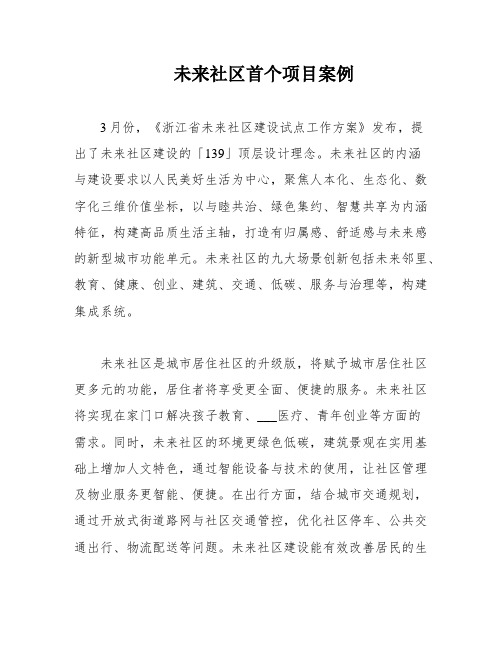
未来社区首个项目案例3月份,《浙江省未来社区建设试点工作方案》发布,提出了未来社区建设的「139」顶层设计理念。
未来社区的内涵与建设要求以人民美好生活为中心,聚焦人本化、生态化、数字化三维价值坐标,以与睦共治、绿色集约、智慧共享为内涵特征,构建高品质生活主轴,打造有归属感、舒适感与未来感的新型城市功能单元。
未来社区的九大场景创新包括未来邻里、教育、健康、创业、建筑、交通、低碳、服务与治理等,构建集成系统。
未来社区是城市居住社区的升级版,将赋予城市居住社区更多元的功能,居住者将享受更全面、便捷的服务。
未来社区将实现在家门口解决孩子教育、___医疗、青年创业等方面的需求。
同时,未来社区的环境更绿色低碳,建筑景观在实用基础上增加人文特色,通过智能设备与技术的使用,让社区管理及物业服务更智能、便捷。
在出行方面,结合城市交通规划,通过开放式街道路网与社区交通管控,优化社区停车、公共交通出行、物流配送等问题。
未来社区建设能有效改善居民的生活环境,契合民生的需求。
同时,对于实施城市有机更新,促进城市升级及经济发展也具有积极作用。
未来社区的建设将成为城市发展的新增长点。
未来社区的建设将选择城市中最小、分布最多的生态单元入手,加入绿色低碳、智慧互联、设施共享、功能集成等新时代的新元素。
未来社区的升级将带动环保材料、智能安防设备、信息化管理系统等产品相关产业的投资需求,进而拉动城市GDP增长。
未来社区作为智慧城市生态体系建设的一个缩影,能推动城市在更长周期维度上向智慧运营城市理念逐步转型。
以未来社区这一微型城市生态为载体与试点,探索利用物联网的落地应用,实现社区的数据化、智能化管理服务,为社区居民生活提供高效、便捷的配套服务,从而推动老旧型社区向智慧型新社区转型。
The first Future Community project has been launched and will be ___ will ritize the high-___ development of above-ground and underground ___。
降低碳排量的方法英文作文

降低碳排量的方法英文作文英文:As a responsible global citizen, I believe it iscrucial for us to find ways to reduce carbon emissions in order to combat climate change. There are several effective methods that can be implemented to achieve this goal.First and foremost, we can reduce our reliance onfossil fuels by promoting the use of renewable energy sources such as solar, wind, and hydro power. For example, many countries have already invested in solar panel installations and wind farms to generate clean energy. By shifting towards these sustainable alternatives, we can significantly decrease our carbon footprint.Furthermore, we can also focus on improving energy efficiency in our daily lives. This can be as simple as using energy-efficient appliances at home, or as complex as implementing energy-saving technologies in industries. Forinstance, I recently upgraded to LED light bulbs in my house, which consume less energy and last longer than traditional incandescent bulbs. Additionally, I have started carpooling with colleagues to reduce the number of vehicles on the road, thereby lowering carbon emissions from transportation.Another effective way to reduce carbon emissions is by promoting sustainable agriculture and forestry practices. By implementing techniques such as crop rotation, organic farming, and reforestation, we can help sequester carbon from the atmosphere. I have personally started supporting local farmers who practice sustainable agriculture, and I also make an effort to purchase products made from sustainably sourced wood.In addition, advocating for policies that limit carbon emissions from industries and incentivize sustainable practices is crucial. This can be achieved through lobbying for stricter environmental regulations and supporting companies that are committed to reducing their carbon footprint. For example, I recently signed a petition urgingmy local government to invest in public transportation and bike lanes to reduce the reliance on cars and decrease carbon emissions from transportation.Overall, there are numerous ways in which we can work towards reducing carbon emissions and combating climate change. By making small changes in our daily lives and advocating for sustainable practices, we can collectively make a significant impact on the environment.中文:作为一个负责任的全球公民,我认为我们必须找到方法来减少碳排放,以应对气候变化。
low-carbon urban planning 低碳城市规划-英国
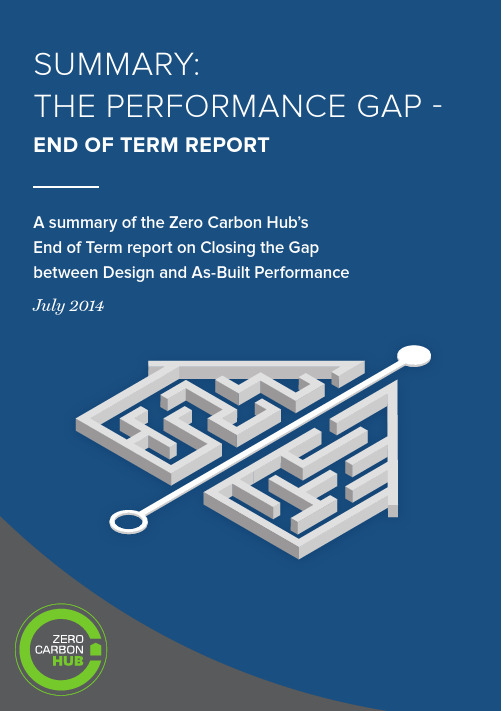
A summary of the Zero Carbon Hub’s End of Term report on Closing the Gap between Design and As-Built Performance July 2014
Energy Literacy
There is limited industry understanding of as-built energy performance and the Performance Gap. This must be urgently addressed in the training of new entrants and the ongoing training of existing practitioners, including everyone from planners and designers to SAP assessors and contractors. An industry recognised card scheme is needed for people to demonstrate the necessary energy performance knowledge and skills.
Areas for Change
A number of solutions, grouped into five key themes, are proposed to address, in particular, the priority issues identified in the Evidence Review Report. While some apply across the entire industry, others may only be relevant to certain sectors, professions or organisations.
低碳生态建筑的设计与实现(英文中文双语版优质文档)

低碳生态建筑的设计与实现(英文中文双语版优质文档)With the improvement of people's awareness of environmental protection and the increasingly serious threat of global climate change, low-carbon ecological buildings have gradually become an important direction in the field of architectural design. Low-carbon ecological buildings refer to minimizing the impact on the environment in all aspects of design, construction, use, and demolition, so as to achieve the goal of sustainable development. This paper will discuss the design and realization of low-carbon ecological buildings.1. Design of low-carbon ecological buildings1. Application of green energy systemGreen energy system is an important part of low-carbon ecological buildings. Architectural designers can apply renewable energy such as solar energy, wind energy, and geothermal energy to buildings to reduce dependence on traditional fossil energy. For example, solar panels can be installed on the roof of the building to power the building through photovoltaic power generation; ventilation openings can be set on the south facade of the building to guide natural wind into the building to achieve natural ventilation and air circulation; Hot water is used for heating and cooling of building air conditioners.2. Using environmentally friendly materialsEnvironmentally friendly materials are an important part of low-carbon ecological buildings. Architectural designers can choose renewable, easily recycled, and low-pollution materials, such as bamboo, hemp rope, and ecological bricks. These materials are produced and used with low environmental impact and are easy to recycle and reuse at the end of the building's life.3. Building energy-saving designBuilding energy-saving design is an important link in low-carbon ecological building design. Architectural designers can reduce the energy consumption of buildings by optimizing the structure of the building, selecting high-efficiency and energy-saving electromechanical equipment, and using efficient lighting systems. For example, energy-saving measures such as double-glazed windows, external wall insulation materials, and energy-saving lamps can be adopted to reduce energy consumption in buildings.4. Application of intelligent control systemIntelligent control system is an important technology in low-carbon ecological buildings. By installing temperature, humidity, light and other sensors inside the building, and monitoring and controlling these data in real time, the goal of energy saving and emission reduction can be achieved. For example, the intelligent control system can be used to adjust the building's temperature, humidity and other environmental parameters, and automatically adjust the building's lighting and air conditioning systems to achieve the best energy-saving effect.2. Realization of low-carbon ecological buildings1. Environmental protection management in building construction processDuring the construction process, attention should be paid to environmental protection and resource conservation to reduce environmental pollution and damage. Construction management personnel should formulate environmental protection management plans and construction schemes, and supervise and manage the construction site. For example, low-carbon and environmentally friendly construction technologies and materials can be used to reduce the generation and discharge of construction waste and waste, and to ensure the cleanliness and sanitation of the construction site.2. Energy-saving management during building useDuring the use of buildings, energy conservation management should be strengthened to reduce energy waste. Building property management personnel should formulate reasonable energy-saving plans according to the characteristics and usage of buildings, and maintain and manage building equipment. For example, building equipment can be regularly maintained and maintained, air-conditioning filters can be cleaned in time, lamps can be replaced, etc., to ensure the efficient operation of equipment.3. Environmental management of building demolition and recyclingBuilding demolition and recycling are also important links in the process of realizing low-carbon ecological buildings. Building demolition management personnel should formulate a demolition plan, and classify and recycle waste during the demolition process. For example, waste concrete, steel and other building materials can be recycled to reduce waste of resources and environmental pollution.3. Advantages of low-carbon ecological buildingsLow-carbon ecological buildings have the following advantages:1. Reduce energy consumption and emissionsLow-carbon ecological buildings adopt environmentally friendly materials, energy-saving technologies and green energy systems, which can greatly reduce energy consumption and emissions of buildings, and reduce carbon emissions and pollutant emissions.2. Improve building quality and user experienceLow-carbon ecological buildings focus on the design concepts of environmental protection, energy saving, health and comfort, which can improve the quality and user experience of buildings, and bring users a better living and working environment.3. Achieving sustainable developmentLow-carbon ecological buildings aim at sustainable development, and realize the harmonious coexistence and sustainable development of buildings and the natural environment by minimizing the impact on the environment. At the same time, low-carbon ecological buildings can also bring positive impetus to local economic and social development.4. Save construction costs and operating expensesAlthough the construction and design costs of low-carbon ecological buildings are high, they can greatly reduce energy and water consumption in long-term use, while reducing maintenance and operating costs, thereby achieving cost savings.5. Increase the value and sustainability of buildingsLow-carbon ecological buildings have high environmental protection, energy saving, health and sustainability values, which can improve the return on investment and market competitiveness of buildings. At the same time, low-carbon ecological buildings can also bring better environmental and social benefits to the area where the building is located.随着人们对环保意识的提高和全球气候变化的威胁日益严峻,低碳生态建筑逐渐成为了建筑设计领域的一个重要方向。
Green Lighthouse_velux CHINA (丹麦第一个零碳公共建筑,绿色灯塔)
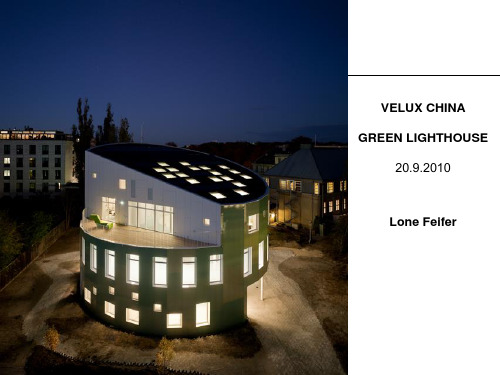
PARTNER MOTIVATIONS
With an ambitious climate plan the City of Copenhagen has launched the wish to make Copenhagen zerocarbon by 2025. This also means that Copenhagen should be a frontrunner within sustainable urban development. The UN Climate Summit in December 2009 will give the City a unique opportunity to raise our profile as one of the ‘environmental lighthouses’ of the world. A city at the cutting edge of new technology and sustainable urban development. Green Lighthouse is an eminent source of inspiration for contractors of the future and the City of Copenhagen has therefore chosen to support the project actively. The close and precise dialogue between the City and the owner in an early phase has optimised the case handling process.
The University of Copenhagen has been one of the initiators of Green Lighthouse and has participated in the entire construction process. Green Lighthouse is part of the University of Copenhagen, and students and researchers of the university will be the daily users of the house.
低碳试点示范建设实施方案
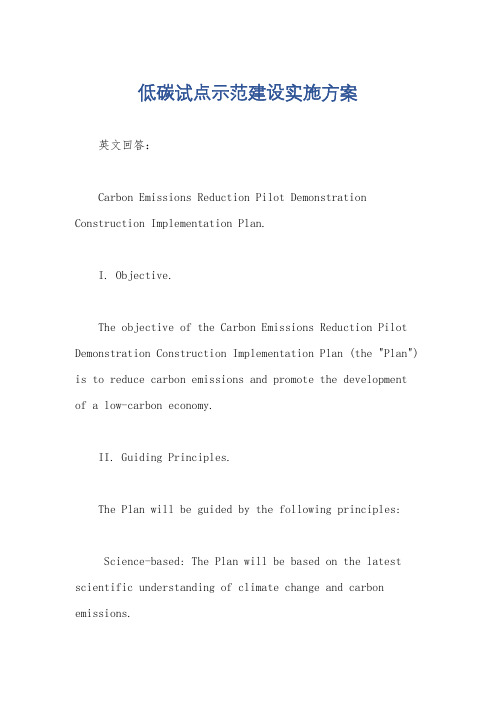
低碳试点示范建设实施方案英文回答:Carbon Emissions Reduction Pilot Demonstration Construction Implementation Plan.I. Objective.The objective of the Carbon Emissions Reduction Pilot Demonstration Construction Implementation Plan (the "Plan") is to reduce carbon emissions and promote the development of a low-carbon economy.II. Guiding Principles.The Plan will be guided by the following principles:Science-based: The Plan will be based on the latest scientific understanding of climate change and carbon emissions.Cost-effective: The Plan will prioritize measures that are cost-effective and have a positive impact on the environment.Equitable: The Plan will ensure that the benefits and costs of carbon emission reduction are shared equitably across society.Innovative: The Plan will encourage the development and deployment of innovative technologies and solutions to reduce carbon emissions.Collaborative: The Plan will be developed and implemented in collaboration with a wide range of stakeholders, including government agencies, businesses, and civil society organizations.III. Key Measures.The Plan will include a range of measures to reduce carbon emissions, including:Energy efficiency: The Plan will promote energy efficiency measures in buildings, industry, and transportation.Renewable energy: The Plan will encourage the development and deployment of renewable energy sources,such as solar, wind, and geothermal energy.Carbon capture and storage: The Plan will support the development and deployment of carbon capture and storage technologies.Forestry and land use: The Plan will promote forestry and land use practices that reduce carbon emissions.Transportation: The Plan will encourage the adoptionof low-carbon transportation modes, such as walking, biking, and public transportation.IV. Monitoring and Evaluation.The Plan will include a comprehensive monitoring and evaluation framework to track progress and assess the effectiveness of the measures. The results of the monitoring and evaluation will be used to inform future updates to the Plan.V. Timeline.The Plan will be implemented over a period of 10 years. The first phase of the Plan will focus on developing and implementing the key measures. The second phase of the Plan will focus on monitoring and evaluating the effectiveness of the measures and making necessary adjustments.VI. Funding.The Plan will be funded through a combination of public and private funds. The government will provide funding for the development and implementation of the key measures. The private sector will be encouraged to invest in low-carbon technologies and solutions.VII. Public Engagement.The Plan will actively engage the public in the development and implementation of the measures. The government will provide regular updates on the progress of the Plan and will seek public feedback on the proposed measures.VIII. International Cooperation.The Plan will promote international cooperation on carbon emissions reduction. The government will work with other countries to share best practices and to support the development and deployment of low-carbon technologies and solutions.IX. Conclusion.The Plan is a comprehensive and ambitious plan to reduce carbon emissions and promote the development of a low-carbon economy. The Plan will be implemented in collaboration with a wide range of stakeholders and will bemonitored and evaluated regularly to ensure that it is effective and equitable.中文回答:低碳试点示范建设实施方案。
低碳环保证书文案英语
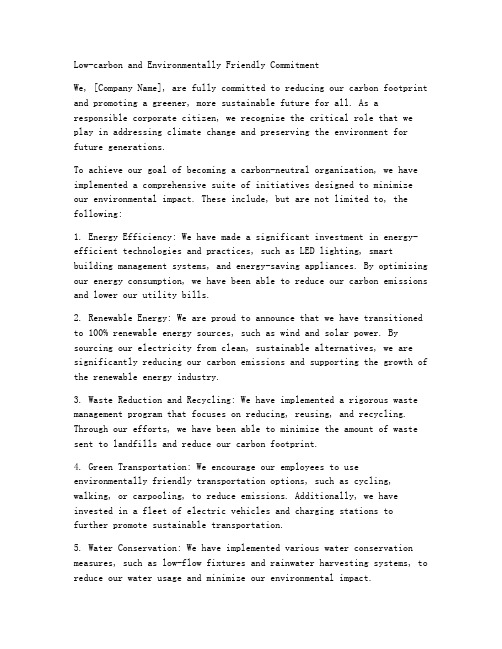
Low-carbon and Environmentally Friendly CommitmentWe, [Company Name], are fully committed to reducing our carbon footprint and promoting a greener, more sustainable future for all. As a responsible corporate citizen, we recognize the critical role that we play in addressing climate change and preserving the environment for future generations.To achieve our goal of becoming a carbon-neutral organization, we have implemented a comprehensive suite of initiatives designed to minimize our environmental impact. These include, but are not limited to, the following:1. Energy Efficiency: We have made a significant investment in energy-efficient technologies and practices, such as LED lighting, smart building management systems, and energy-saving appliances. By optimizing our energy consumption, we have been able to reduce our carbon emissions and lower our utility bills.2. Renewable Energy: We are proud to announce that we have transitioned to 100% renewable energy sources, such as wind and solar power. By sourcing our electricity from clean, sustainable alternatives, we are significantly reducing our carbon emissions and supporting the growth of the renewable energy industry.3. Waste Reduction and Recycling: We have implemented a rigorous waste management program that focuses on reducing, reusing, and recycling. Through our efforts, we have been able to minimize the amount of waste sent to landfills and reduce our carbon footprint.4. Green Transportation: We encourage our employees to use environmentally friendly transportation options, such as cycling, walking, or carpooling, to reduce emissions. Additionally, we have invested in a fleet of electric vehicles and charging stations tofurther promote sustainable transportation.5. Water Conservation: We have implemented various water conservation measures, such as low-flow fixtures and rainwater harvesting systems, to reduce our water usage and minimize our environmental impact.6. Sustainable Procurement: We strive to source our materials and products from suppliers that share our commitment to sustainability. By working with partners who adhere to strict environmental standards, we are able to reduce our carbon emissions and promote a circular economy.7. Employee Engagement: We believe that sustainability starts with our employees, which is why we provide regular training and education on environmental issues. By empowering our team members to make sustainable choices, we are creating a culture of environmental responsibility throughout our organization.By taking these steps, we are not only reducing our carbon emissions and minimizing our impact on the environment but also setting a precedentfor other businesses to follow. We are committed to ongoing innovation and improvement, as we work towards a future where low-carbon and environmentally friendly practices are the norm.We invite you to join us in our journey towards a more sustainable future. Together, we can make a difference and leave a positive impact on our planet.。
电力系统绿色低碳标准体系建设指南
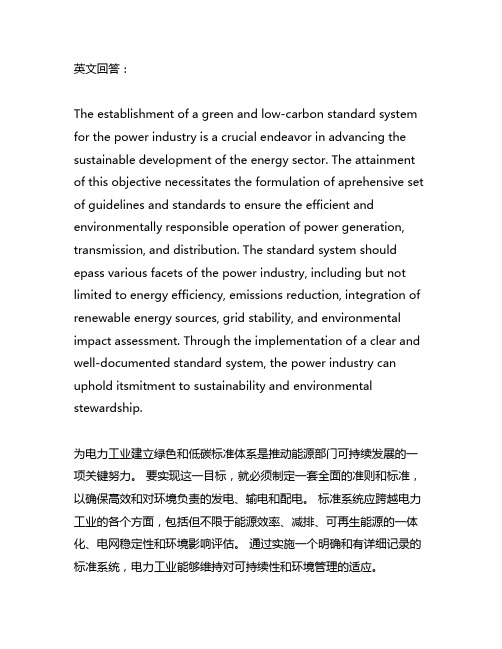
英文回答:The establishment of a green and low-carbon standard system for the power industry is a crucial endeavor in advancing the sustainable development of the energy sector. The attainment of this objective necessitates the formulation of aprehensive set of guidelines and standards to ensure the efficient and environmentally responsible operation of power generation, transmission, and distribution. The standard system should epass various facets of the power industry, including but not limited to energy efficiency, emissions reduction, integration of renewable energy sources, grid stability, and environmental impact assessment. Through the implementation of a clear and well-documented standard system, the power industry can uphold itsmitment to sustainability and environmental stewardship.为电力工业建立绿色和低碳标准体系是推动能源部门可持续发展的一项关键努力。
英语作文低碳环保的设计意图
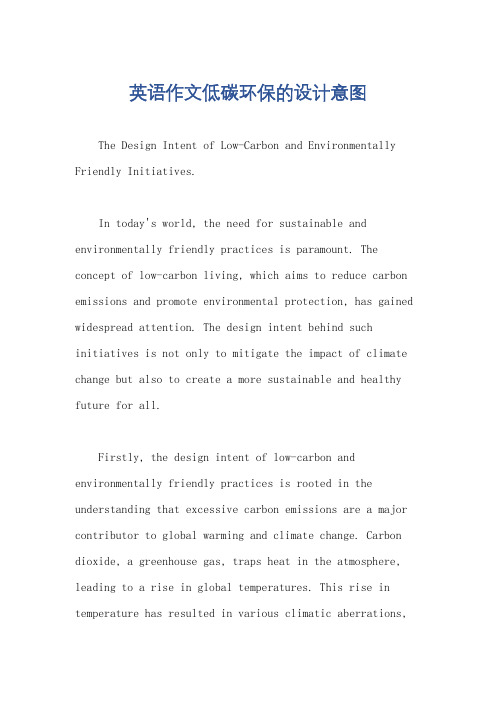
英语作文低碳环保的设计意图The Design Intent of Low-Carbon and Environmentally Friendly Initiatives.In today's world, the need for sustainable and environmentally friendly practices is paramount. The concept of low-carbon living, which aims to reduce carbon emissions and promote environmental protection, has gained widespread attention. The design intent behind such initiatives is not only to mitigate the impact of climate change but also to create a more sustainable and healthy future for all.Firstly, the design intent of low-carbon and environmentally friendly practices is rooted in the understanding that excessive carbon emissions are a major contributor to global warming and climate change. Carbon dioxide, a greenhouse gas, traps heat in the atmosphere, leading to a rise in global temperatures. This rise in temperature has resulted in various climatic aberrations,such as extreme weather events, melting ice caps, andrising sea levels. To address this issue, it is crucial to reduce carbon emissions and adopt sustainable practicesthat promote environmental conservation.Secondly, the design intent also aims to promote resource efficiency and waste reduction. In a low-carbon lifestyle, individuals and organizations are encouraged to make use of renewable energy sources like solar, wind, and hydropower. These energy sources not only reduce carbon emissions but also help in conserving finite fossil fuels. Furthermore, recycling, reuse, and reduction of waste are key components of this design intent. By minimizing waste production and maximizing resource efficiency, we can reduce the environmental footprint of our activities.Moreover, the design intent of low-carbon and environmentally friendly practices is to foster a culture of environmental awareness and responsibility. By promoting sustainable practices, we aim to raise awareness among individuals and communities about the importance of protecting the environment. This, in turn, encouragespeople to make informed choices that prioritize environmental conservation, such as purchasing energy-efficient appliances, using public transportation or cycling, and supporting companies that adopt sustainable business practices.Additionally, the design intent is to create a platform for innovation and collaboration. By encouraging the development of low-carbon technologies and solutions, we aim to foster a culture of innovation that leads to the creation of more sustainable products and services. Furthermore, collaboration among governments, businesses, communities, and individuals is crucial in achieving the goal of a low-carbon future. By working together, we can share knowledge, resources, and best practices to accelerate the transition to a more sustainable world.In conclusion, the design intent of low-carbon and environmentally friendly practices is to create a sustainable and healthy future for all. It aims to mitigate the impact of climate change by reducing carbon emissions, promoting resource efficiency, waste reduction, andfostering environmental awareness and responsibility. By working together and adopting sustainable practices, we can build a world that is more resilient to the challenges of climate change and ensure a better future for generations to come.。
低碳环保倡议书英文
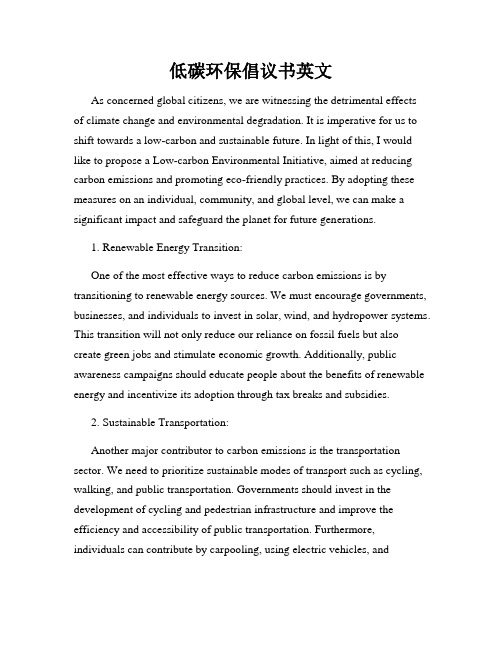
低碳环保倡议书英文As concerned global citizens, we are witnessing the detrimental effectsof climate change and environmental degradation. It is imperative for us to shift towards a low-carbon and sustainable future. In light of this, I would like to propose a Low-carbon Environmental Initiative, aimed at reducing carbon emissions and promoting eco-friendly practices. By adopting these measures on an individual, community, and global level, we can make a significant impact and safeguard the planet for future generations.1. Renewable Energy Transition:One of the most effective ways to reduce carbon emissions is by transitioning to renewable energy sources. We must encourage governments, businesses, and individuals to invest in solar, wind, and hydropower systems. This transition will not only reduce our reliance on fossil fuels but also create green jobs and stimulate economic growth. Additionally, public awareness campaigns should educate people about the benefits of renewable energy and incentivize its adoption through tax breaks and subsidies.2. Sustainable Transportation:Another major contributor to carbon emissions is the transportation sector. We need to prioritize sustainable modes of transport such as cycling, walking, and public transportation. Governments should invest in the development of cycling and pedestrian infrastructure and improve the efficiency and accessibility of public transportation. Furthermore, individuals can contribute by carpooling, using electric vehicles, andpracticing eco-friendly driving habits such as maintaining proper tire pressure and reducing idling time.3. Waste Reduction and Recycling:The issue of waste management needs to be addressed to minimize the environmental impact of our consumption patterns. Governments should implement stringent waste reduction policies, promote recycling programs, and incentivize the use of eco-friendly packaging. Individuals can actively participate by reducing single-use plastic consumption, practicing proper waste segregation, and supporting local recycling initiatives. Additionally, the concept of a circular economy, where products are designed for durability and recyclability, should be promoted.4. Conservation and Reforestation:Preserving and restoring natural ecosystems is crucial for mitigating climate change and protecting biodiversity. Governments should increase protected areas, enforce stricter regulations against deforestation, and invest in reforestation projects. Individuals and communities can contribute by participating in tree planting initiatives, supporting conservation organizations, and advocating for sustainable land use practices.5. Education and Awareness:Educating the public, especially the younger generation, about the importance of low-carbon and environmentally friendly practices is essential. Schools should incorporate environmental education into their curriculum, emphasizing the significance of sustainability. Awareness campaigns,workshops, and community events can help educate people about the environmental challenges we face and encourage them to take action.In conclusion, by embracing a low-carbon environmental initiative, we can address the urgent need to reduce carbon emissions and promote sustainable practices. The proposed measures, including transitioning to renewable energy, promoting sustainable transportation, waste reduction, conservation efforts, and raising awareness, can pave the way for a greener future. It is crucial for governments, businesses, and individuals to collaborate and commit to these practices. Let us all unite in our efforts to build a sustainable and environmentally friendly world for ourselves and for future generations. Together, we can make a difference.。
建设工程绿色低碳标杆示范实施计划
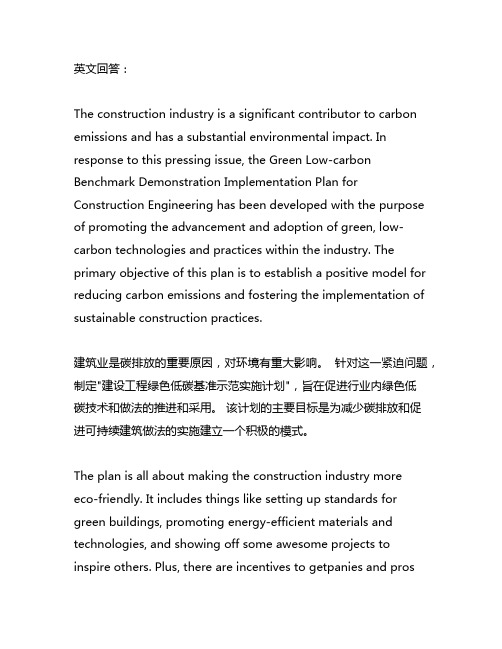
英文回答:The construction industry is a significant contributor to carbon emissions and has a substantial environmental impact. In response to this pressing issue, the Green Low-carbon Benchmark Demonstration Implementation Plan for Construction Engineering has been developed with the purpose of promoting the advancement and adoption of green, low-carbon technologies and practices within the industry. The primary objective of this plan is to establish a positive model for reducing carbon emissions and fostering the implementation of sustainable construction practices.建筑业是碳排放的重要原因,对环境有重大影响。
针对这一紧迫问题,制定"建设工程绿色低碳基准示范实施计划",旨在促进行业内绿色低碳技术和做法的推进和采用。
该计划的主要目标是为减少碳排放和促进可持续建筑做法的实施建立一个积极的模式。
The plan is all about making the construction industry moreeco-friendly. It includes things like setting up standards for green buildings, promoting energy-efficient materials and technologies, and showing off some awesome projects to inspire others. Plus, there are incentives to getpanies and proson board with the whole green, low-carbon thing. Basically, the plan wants to change the construction game to make it more sustainable.计划全部是为了让建筑业更加生态友好。
国外碳中和方法
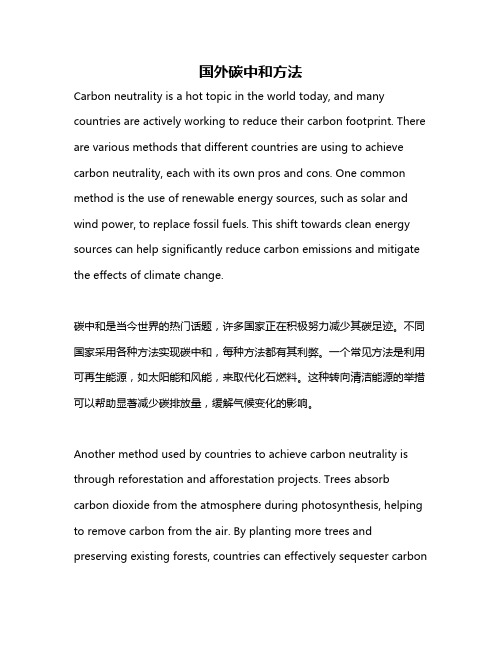
国外碳中和方法Carbon neutrality is a hot topic in the world today, and many countries are actively working to reduce their carbon footprint. There are various methods that different countries are using to achieve carbon neutrality, each with its own pros and cons. One common method is the use of renewable energy sources, such as solar and wind power, to replace fossil fuels. This shift towards clean energy sources can help significantly reduce carbon emissions and mitigate the effects of climate change.碳中和是当今世界的热门话题,许多国家正在积极努力减少其碳足迹。
不同国家采用各种方法实现碳中和,每种方法都有其利弊。
一个常见方法是利用可再生能源,如太阳能和风能,来取代化石燃料。
这种转向清洁能源的举措可以帮助显著减少碳排放量,缓解气候变化的影响。
Another method used by countries to achieve carbon neutrality is through reforestation and afforestation projects. Trees absorb carbon dioxide from the atmosphere during photosynthesis, helping to remove carbon from the air. By planting more trees and preserving existing forests, countries can effectively sequester carbonand offset their emissions. Reforestation projects not only help mitigate climate change but also provide habitats for wildlife and improve air quality.实现碳中和的另一种方法是通过造林和植树造林项目。
低碳环保协议书英语作文
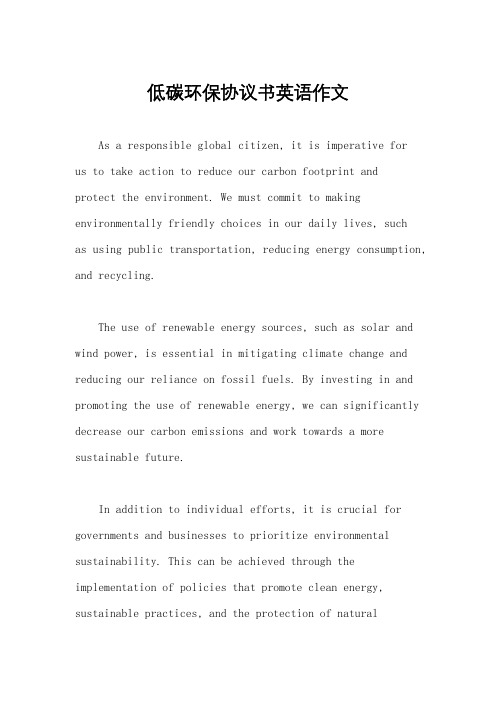
低碳环保协议书英语作文As a responsible global citizen, it is imperative forus to take action to reduce our carbon footprint andprotect the environment. We must commit to making environmentally friendly choices in our daily lives, suchas using public transportation, reducing energy consumption, and recycling.The use of renewable energy sources, such as solar and wind power, is essential in mitigating climate change and reducing our reliance on fossil fuels. By investing in and promoting the use of renewable energy, we can significantly decrease our carbon emissions and work towards a more sustainable future.In addition to individual efforts, it is crucial for governments and businesses to prioritize environmental sustainability. This can be achieved through the implementation of policies that promote clean energy, sustainable practices, and the protection of naturalhabitats.Education and awareness are key components in the fight against climate change. By educating the public about the importance of environmental conservation and the impact of our actions on the planet, we can inspire others to take action and make a positive difference.Collaboration and cooperation among nations are essential in addressing global environmental challenges. By working together, we can share knowledge, resources, and best practices to develop effective solutions and create a more sustainable world for future generations.In conclusion, by committing to environmentallyfriendly practices, promoting renewable energy, implementing sustainable policies, and raising awareness, we can work towards a low-carbon, environmentally friendly future. It is our collective responsibility to protect the planet and ensure a healthy and sustainable environment for all.。
保护环境的英语短语有哪些优秀3篇
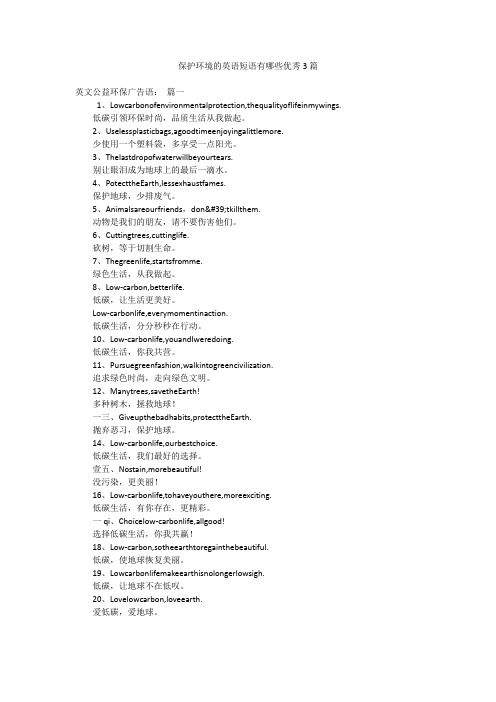
保护环境的英语短语有哪些优秀3篇英文公益环保广告语:篇一1、Lowcarbonofenvironmentalprotection,thequalityoflifeinmywings.低碳引领环保时尚,品质生活从我做起。
2、Uselessplasticbags,agoodtimeenjoyingalittlemore.少使用一个塑料袋,多享受一点阳光。
3、Thelastdropofwaterwillbeyourtears.别让眼泪成为地球上的最后一滴水。
4、PotecttheEarth,lessexhaustfames.保护地球,少排废气。
5、Animalsareourfriends,don'tkillthem.动物是我们的朋友,请不要伤害他们。
6、Cuttingtrees,cuttinglife.砍树,等于切割生命。
7、Thegreenlife,startsfromme.绿色生活,从我做起。
8、Low-carbon,betterlife.低碳,让生活更美好。
Low-carbonlife,everymomentinaction.低碳生活,分分秒秒在行动。
10、Low-carbonlife,youandIweredoing.低碳生活,你我共营。
11、Pursuegreenfashion,walkintogreencivilization.追求绿色时尚,走向绿色文明。
12、Manytrees,savetheEarth!多种树木,拯救地球!一三、Giveupthebadhabits,protecttheEarth.抛弃恶习,保护地球。
14、Low-carbonlife,ourbestchoice.低碳生活,我们最好的选择。
壹五、Nostain,morebeautiful!没污染,更美丽!16、Low-carbonlife,tohaveyouthere,moreexciting.低碳生活,有你存在,更精彩。
低碳相关英语词汇
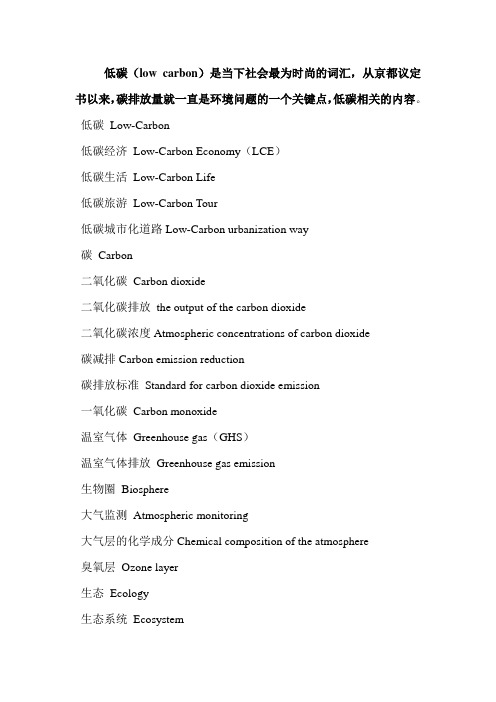
低碳(low carbon)是当下社会最为时尚的词汇,从京都议定书以来,碳排放量就一直是环境问题的一个关键点,低碳相关的内容。
低碳Low-Carbon低碳经济Low-Carbon Economy(LCE)低碳生活Low-Carbon Life低碳旅游Low-Carbon Tour低碳城市化道路Low-Carbon urbanization way碳Carbon二氧化碳Carbon dioxide二氧化碳排放the output of the carbon dioxide二氧化碳浓度Atmospheric concentrations of carbon dioxide碳减排Carbon emission reduction碳排放标准Standard for carbon dioxide emission一氧化碳Carbon monoxide温室气体Greenhouse gas(GHS)温室气体排放Greenhouse gas emission生物圈Biosphere大气监测Atmospheric monitoring大气层的化学成分Chemical composition of the atmosphere臭氧层Ozone layer生态Ecology生态系统Ecosystem环境指标Environmental indicators环境政策Environmental policy环境风险评估Environmental risk assessment可持续发展Sustainable developmentPresently, a new lifestyle called low-carbon life is spreading every corner of our country. The concepts of low-carbon are low energy and no waste.It is such a significant project that I can’t wait to present my ideas on how to promote it.On the first place, a no-car day is supposed to set up every week in our school. Because cars not only cause serious air pollution but also waste energy. On on-car day, neither students nor teachers are allowed to drive to school. Meanwhile, just walk, jump, cycle or run. Use our legs and enjoy the fun. On the second place, we had best not use plastic bags any more. No one can stand the “white pollution”. So, it is wise to use bags which can be reused again and again. Finally,one thing that we should keep in mind: every big thing comes from the subtle. Therefore, as students, we ought to turn out the lights the moment we leave, turn off the tap in time, and reuse our textbook and so on.All in all, it weighs greatly for all of us to put the low-carbon lifestyle into practice. Just set our mind to these: no-car day, no plastic bags, and no waste. Let’s do it now.新华社报道:The National Development and Reform Commission has confirmed the government will take concrete actions to develop a low-carbon economy after it pledged to substantially reduce carbon intensity at last year's Copenhagen Conference.国家发展与改革委员会已证实政府将采取切实行动,发展低碳经济。
- 1、下载文档前请自行甄别文档内容的完整性,平台不提供额外的编辑、内容补充、找答案等附加服务。
- 2、"仅部分预览"的文档,不可在线预览部分如存在完整性等问题,可反馈申请退款(可完整预览的文档不适用该条件!)。
- 3、如文档侵犯您的权益,请联系客服反馈,我们会尽快为您处理(人工客服工作时间:9:00-18:30)。
Low Carbon Design - First ConsultationThe Brief:Design Direction IMainly looks at the production process, cutting carbon emission via use of new technologyand renewable energy. Through optimizing the design on product structure/components, upgrading manufacturing infrastructure to achieve CO2 reduction. Look at the mechanicdesign of production line, space requirement and product transportation.Design Direction IIMainly look at the recycling & reuse of after-life products.Design Direction IIILook at the services being provided to a product during its life cycle (manufacturing, sells,use and after use) suggest on new mode of product service.Team AYou need to consider the detail of the Design Directions more carefully.For any product, consider:∙Real carbon emission savings∙The user and potential market∙Lifecycle∙More radical thinkingFridge energy saving concept∙Look at what is on the market already in domestic and commercial situations∙Need to consider the user. Why would they want these improvements?∙Reducing carbon emissions is essential to protect your future. Be more ambitious and radical in your thinking.Water saving concept∙Need to consider any detergents that may be in the waste water.∙Why should anyone adopt this system? Can it be easily retrofitted onto existing sinks? Is water metering an issue in China?∙Nice sketches on Slide 9.Dehumidifier concept∙How much water does the dehumidifier produce and is it more than plants are likely to need?∙Who would be the customer for this?Electricity saving reminder∙Look at products on the market already (there are several in the UK)∙Why would people want this product?Radiator∙Look at what is on the market alreadyShower∙Think about your user. Who would install this shower? How can you make the experience to water saving desirable?∙Is there water metering in China? If not will it come soon? Would it come from legislation?∙Could the unit be remanufactured?∙What would the business model be for the shower?Team BYou need to consider the detail of the Design Directions more carefully.For any product, consider:∙Real carbon emission savings∙The user and potential market∙Lifecycle∙More radical thinkingElectronic paper∙Research:o I assume you are talking about the concept of making an electronicnewspaper but you need to be clearer and more concise in what you aretrying to say (it was not at all clear what you were reporting until slide 21) o Slide 25: These things may be true in the immediate sense, but remember that your electronic newspaper cannot exist without other products that willuse oil etc.∙Stakeholders:Need to understand the stakeholders that will benefit from your design, their needsand how you can benefit them.∙Users: Need more research into the potential users of your design. What are their needs and why will they use your product?∙Lifecycle: Need to consider the lifecycle and add more depth. Suggest you speak with Team C.Recoverable Tableware∙Your research is interesting and appears to offer some insight, but it is unclear what problem you are trying to solve. You need to identify real needs, and justify themclearly.∙Look more closely at the Design Directions∙You need to consider the lifecycle and business model of any product you design, along with incentives for the different stakeholders to reduce CO2 emissions,promote responsible production and End-of-Life practices throughout the process.∙Canteen:o If the canteen cutlery and plates were cleaned properly, would the students use them? Who is doing the cleaning and why is it not done properly?o Maybe the real problem is the canteen’s poor cleaning, or the students’ laziness and shyness? Perhaps this suggests something about the society,education, staff morale, students’ upbringing, negative behaviour andinsecurity. These are all problems that you could try to solve.o Where is most CO2 emitted in this situation? In the production of energy from the air conditioner? How do students travel to the canteen - diesel bus?In the lighting of the canteen? Are there TVs as well?o It would be helpful to research and learn from other canteens and eating environments.∙Lunchbox:o Does the world really need another lunchbox?!?!o A lunchbox suggests that the students would make their own lunch at home and bring it to GAFA. But you say several times that the students are lazy.o Think about what foods need to be stored in the lunchboxo The concept that flat-packs could be good for distribution, but what about leakage of wet foods?o Why would anyone be bothered to recycle the product?o AVOID PVC! It is very bad for the environment.o Nice sketching style.Team CIn particular, please consider more:∙Real carbon emission savings∙The user and potential market∙More radical thinkingReport∙Research:Very interesting research. Generally clear communication, good mixture of facts,figures and graphics, but it would be good to see some more detail and sources forthe figures. You say at the end that you will do more research, so that’s good.o Be clearer about where and when the CO2 emissions are releasedo Identify the priorities i.e. what product results in the most CO2 beingemitted?∙Stakeholders: Need to understand the stakeholders that will benefit from your design, their needs and how you can benefit them. Stakeholders may include thepeople who are harmed by the current situation, waste collectors/transporters,developed countries who export the waste to China, government, sellers of thematerials extracted etc∙Users: Need to research the potential users of your designs. What are their needs and why will they use your product?Design – low carbon Light presentation∙Object choice: After all your research, why have you come to the conclusion that a light is the best direction?o Have a look at: /science-technology/how-many-lightbulbs∙Evidence:o Be more precise with your statistics and sources. They way you have used the figures does not make them sound credible.o Why do you focus on Britain’s energy f igures?∙CO2 savings:Think what has to happen for your light to result in CO2 emissions savings. You need to make sure your design is better than competitor products (functionality and priceetc), and results in your competitor manufacturing less.o I am concerned that your light concepts appear to offer at best, smallincremental CO2 emissions reductions. You need to be more ambitious andradical.o Try to think more radically. Go back to the beginning and think about why people need artificial lights. Think about the society the user lives in. Maybethere are more radical solutions to be found there … ?∙Business model:Think about the business model, stakeholders at every stage of the lifecycle, who will benefit and how etc∙Materials:Be clearer on where materials will come from. Who are the stakeholders and how will they benefit from your design?∙Manufacture & Distribution:Your system of local manufacture and distribution sounds good, but you need towork out more detail. Who are the stakeholders and how will they benefit from your design?∙Use:At a guess, the biggest environmental impact of the light will be from its use phase.Maybe there is some way to guarantee your light will be powered by renewableelectricity. Or perhaps there is a way you can use your light as a catalyst, by which a household gets renewable energy for the entire house.Who are the stakeholders and how will they benefit from your design?∙End of Life:Why would anybody recycle the light? What is the market for the materials? Think about it’s business model and how you can incentivise recycling or a less carbonemitting process like remanufacture.∙General:o Need to do a lifecycle assessment (LCA), even a quick one would be useful to show improvements (if any) against a baseline product and system.o Be careful with your use of English. On pg 4 of your Low Carbon Light PowerPoint, you use ‘recyclable’, but perhaps you mean ‘recycled’?。
